
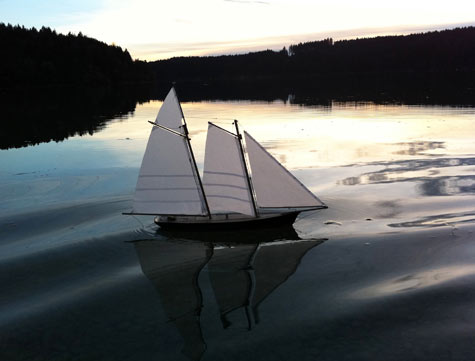
Phillip Artweger's little America sails as the sun goes down
Just to be totally contrary to headline order of mention and because some may be anxious to know who won, I will `let the last be first’ by telling you about the email hunt to find the smallest RC and freesail schooner models on Planet Earth.
It was a joint effort, the writers challenge in association with Marine Modelling International, the Traplet publication, Duckworks (that you are logged onto at the moment!) and the US Vintage Model Yacht Group publication, The Model Yacht. Those who have already bought or received their copies of the February issue of the first mentioned which would have hit the newsstands in late January will already know the results, but for others (except the winners whom I notified by email) well here goes.
The idea for my challenge actually started while seated one wet New Zealand Winter morning on our `porcelain pony’ (well, many people get their best ideas in the loo!), that of wondering just how small a model schooner could be made to incorporate radio control. I made it as easy as possible in that the entries could be scratchbuilt or kit-adapted and aware of the ingenuity of some keen modelers, I envisaged that an eight or nine inch length on deck model would be about the limit, in other words a 12” Footy would just not be competitive. Was I surprised? Was I ever!

Cecil Tiller (North Carolina) built free sail America 4-3/8 " on deck
Surrey UK's Jim Dewar's scow, nicely built but 150mm length on deck so not small enough |
Cecil playing things close to his chest |
I then included a freesail division, offered an award in each of the two classes and along with Marine Modelling International, Duckworks and The Model Yacht we set about making it known. Publications can on occasion cooperate if nicely asked!

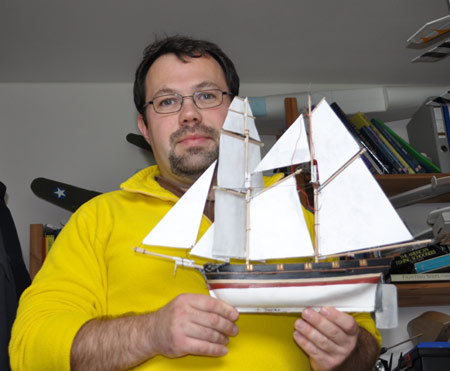
Phillip Artweger with St Helena an RC early leader at 8" on deck
On a modeling Forum website, thanks to Harry Duncan I had found Phillip Artweger, a Skyvan pilot from Austria flying out of Klatovy in the Czech Republic. A micro ship modeler he had used a Constructo kit and built an RC Brigantine schooner called St Helena that I fell in love with. It had a length on deck of just eight inches. I saw a video of it sailing and I persuaded him to let me enter it in the Challenge. We became friends and the model became an early benchmark boat to beat.
Then within days, my friend Alistair Roach in the UK entered two of his intriguing little Cokyn Baba cork-hulled boats, the smaller of the two (a schooner called Glasgow at 2.5” he specially built) and that freesail entry
became the benchmark for that division. And so a little flood of enthusiasm and interest commenced and within weeks more boats (many totally unsuitable because they were either too large, and quite a few were not schooner-rigged.) Two were bottle boats, one of those a schooner, the other a ketch there were three Footy boats, one of them a sloop the other a ketch and two owners sending a photograph had not tested their boats on the water and one said that his `could be made to sail!’. Another sent me an image of a drawing and said he would be entering next year! (Next year??? Nobody has told me that there is another contest!)
George Surgent's Ity 3" deck length and proof! |
An entry from Maine, a nice schooner called Shorty at 3.50 inches |
14 year old Kelson Mills of Washington's
60bb model of Alcyone was a commendable effort |
Free sail Runner Up Thumbelina >From Peter Noble of Texas - 42mm on deck |
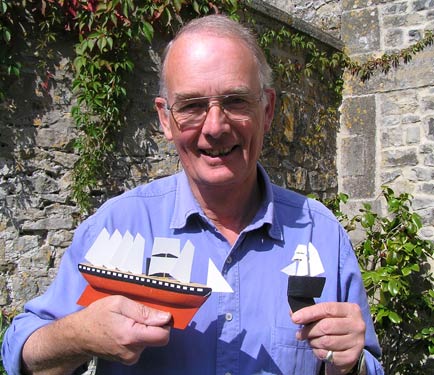
Early entrant Alistair Roach of UK with two entries, the bigger of the the two SS Great Britain and the freesail leader for some time, a 2.5" schooner Glasgow
The winner of the smallest freesail model came into contention the day before entries closed, slipping over the line to take honours by a small margin of about 3mm from Peter Noble, a Scot domiciled in Texas, USA whose little schooner Thumbelina appeared to be a clear winner at 41mm in length. The little schooner-rigged scow of Harry Duncan of Hamilton East, the only New Zealander to enter became the winner, Noble relegated to the Runner Up position and its medallion award. Harry’s scow was just 38mm in deck length – that is 1.496o6299 inches
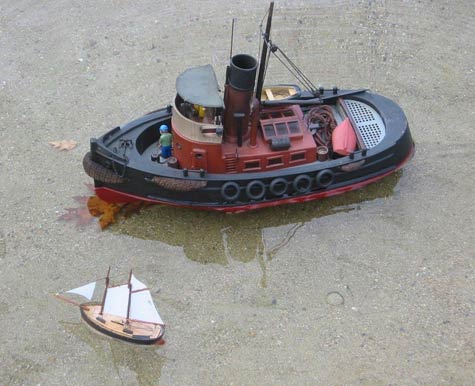
Mike deLesseps' Suzanne the RC
Runner Up with his tug Brutus
There were several excellent and quite amazing freesail entries including a lovely America from North Carolina man, Cecil Tiller that was 4 and three eighth inches length on deck, another America as a second entry from Phillip Artweger and another schooner from George Surgent of Seaworthy Small Ships in Maryland that measured just three inches on deck.
Another was Shorty from Maine, USA man model shipbuilder, Mike deLesseps.
I wanted to give a special Wee Tiddler award to Somerset, UK man Alistair Roach for his amazing 1826 era 1/400 scale Topsail schooner, a Cornish Cokyn Baba of 2.15 inches called Glasgow. I would love to have given Cecil and George and Phillip awards as well but as the Chief (and only) `Financing Officer’ for the Challenge I just couldn’t.

Smallest RC model on Planet Earth. Gypsy II with Hans S Berger
Gypsy II on the water |
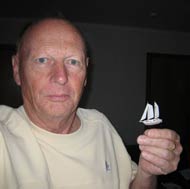
Harry Duncan with smallest free sailing schooner
the NZ scow Mark Steele |
Right then – who won the principal award for the smallest RC schooner I hear you say! Well there were fewer entrants than freesail and the winner of the smallest RC schooner on Planet Earth was Hans Berger of Plainville, Connecticut fpr his topsail schooner with 3 channel RC Gypsy II with a deck measurement of 3.905 inches. Mike deLesseps of Maine in the US. For his second entry schooner Suzanne took the runner award. The boat was well thought out, a good looker and quite enchanting, I loved the photograph he took of it in the shallows with his little tug Brutus.
Phillip Artweger’s little RC America |
Freesail division Runner Up Peter Noble with schooner Thumbelina
|
Mike deLesseps with Suzanne after a test sail |
Maryland’s George Surgent with his freesail entry ITY – a beauty but not a winner |

This was a fun`challenge’ principally to set minds thinking, firstly about schooners (a type of sailing boat dear to the hearts of many) and secondly for some to prove that it was indeed possible to `go for the jugular’ and build the smallest ever model schooners that could sail. Harry of Hamilton East in New Zealand who built the little scow certainly did. Well what now? Maybe someone should form the Little Sailing Schooners of Planet Earth Association, keep track of these forerunners and promote the `think small’ Schooner message, perhaps even seek some space on an existing website for reflecting and remembering what turned out to be `possible, and encouraging others!’ Whadja fink? (Good name for a model sailing ship that!)
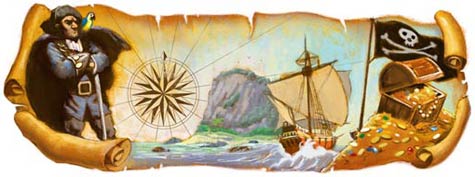
I am a fan of Google, (there I’ve said it!) one of millions of `googlers’ who use Google daily and `google away’ on their search engine engaged in information hunting. I refuse to get into the `politics’ of China `Google bashing’ or what others don’t like about Google for one will never please everyone at the same time (one of the things my late father used to say to me…you can’t please all of the people all of the time!)
Another thing I like about Google is their search engine artwork that changes periodically. Soft tones and classy brushwork are the main attributes
and the one shown above should please the seafarers and those with even a passing interest in the pirates of yesteryear. Refreshingly unlike the style of brash and bold and brassy headings that yell at you just to tell you that it is GOOGLE! Google it, keep on googling!
The variety of
model yacht usage |
I have tried over the years to delve into as many aspects of use of model yachts. Varied’ is the word and in so doing I have tried to point out that it is so much more than just International Class racing in which many lose interest and exit after a relatively short sojourn because of their inability of winning and because of the expense entailed just to get competitive and keep going. The `super-seriousness’ also puts people off as it has that aptitude of bringing arguments and resulting in flared tempers. It put me off I can tell you, what’s more it gave birth in my mind to the more enjoyable use of model yachts `socially’ in what to what I referred to as `windling’.
This style was to even get rid of the stigma of a man being just seen with a model yacht. Go to many ponds today and see how many grown men are enjoying `just sailing’ – stigmas gone it is wonderful sight… and they are not frowning and abusing each other either!`
I am not against racing, and those who enjoy it will continue to do it, and there will be occasional bouts of aggravation as tempers of the over-zealous `I know the rules backwards’ types are demonstrated, but not where and when the Auckland Ancient Mariners sail, at least not when I am around! It is the attitude that it often seems to bring with it which taints it, perhaps moreso for us in the older generation who look at time spent model yacht sailing as non-argumentative `quality time’ in what are our Golden years.


Hans Berger with his Canterbury J yacht
Jeff Davenport and his Canterbury J Class |
Ron Rhault with his Canterbury J |
John Kostang’s Canterbury J with attractive deck arrangement |
Steve Gromko’s stunning J |
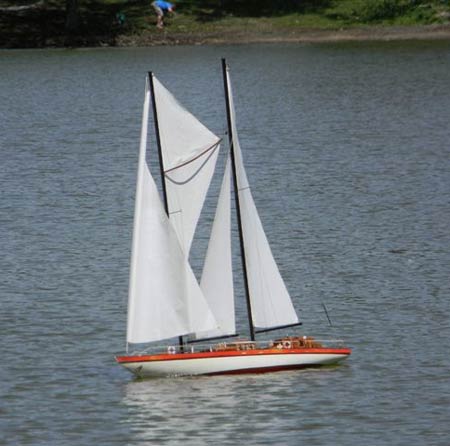
Hans Berger's Atlantis under sail
At the Paderewski Model Yacht Club in Paderewski Park, in Plainsville,Connecticut, USA, the New Zealand Canterbury J Class boats are being embraced by a small but growing number of members and have their own class. They originate in Christchurch, New Zealand but seem to have been taken into the hearts of ten members at Paderewski where Commodore, Hans Berger owns and sails one within a club formed ten years ago in November 2001 that welcomes a variety of other classes. This incidentally is the same Hans Berger who built the smallest Model schooner on the planet you just read about in this same issue.
The writer remembers many years back on a business trip to that southern city in New Zealand meeting Dave Heanly who had one of the early Canterbury J’s. I was so taken by the way his boat sailed, and how pretty the hull was that I bought a new hull going a-begging and this resulted in my turn-of-the-century looking ketch Marigold which I still own.
But back to Paderewski where the sailing on the beautiful lake is laid back and tailored to enjoyement in addition to those who choose to lean towards the competitive racing side. Currently eleven types of boats form classes sailed there on Wednesday evenings until Sunset during Spring, Summer and Fall months, and on Saturdays from late morning,10am until 2pm.
EC12’s, Fairwinds, Star 45’s, Soling, Laser’s Seawind’s One Metres, Mini Soling’s, Vintage Marblehead, Footy and Canterbury J’s comprise individual fleets that sail within the club programme
An Auckland built Atlantide |

Atlantide model
`At sea' with the ducks |
Superstructure close-up |
There are cases where two boats go hand in glove, they are considered `an item’ if you like when they are owned by the same person. Tom Perkins owned (maybe he still owns?) the 37m 1930 built motor yacht called Atlantide, his newer boat being the Maltese Falcon and he used (or uses) one (the Atlantide) to cruise aboard and watch the ultra-modern MF sail in classic and other regattas. On other occasions Perkins has used it as a `tender’ to his fine Herreshoff schooner Mariette.
The trouble about building a sailing model of Atlantide is that laying ones hands on any form of drawing or plan appears verboten and for the ordinary ship modeler `such help does not appear to exist. So what do the determined and dogged resort to – they look at photos and carefully draw their own plans using photographs (or is it `plan their own drawings’) and with determination produce an above average model of some distinction.
Such is Derek Nicholson and while Rick Mayes in Maroochydore, Queensland works away on his sailing model of his model of the Maltese Falcon (alias `the sister ship’) Derek’s model of Atlantide has become a reality.
ANOTHER ROUNDING
OF THE HORN |
Hey you guys looking for a really good read! I have just been round Cape Horn for the third time via the book My Old man and the Sea by father and son David and Daniel Hays who did it in the little Vertue, Sparrow. It is a good read that seems to get better with each `rounding’.
For those who love both the sea and little sailboats sent out to conquer often treacherous ocean waters, I can heartily recommend this well written book. Daniel Hays writes so damn well and with such a lovely style, and his second book On Whale Island published by Algonquin Books is equally enjoyable, and is one of those books that one savours and does not want to end.
As a journalist I suppose that my only regret was the apparent unavailability of a few photos of David or Daniel aboard Sparrow which would have given this little `tri-para’ mark of appreciation a bit more interest to it. If I live a few more years I think I could well do another rounding of the infamous horn by way of this great little book.
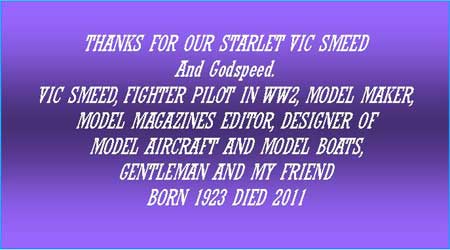

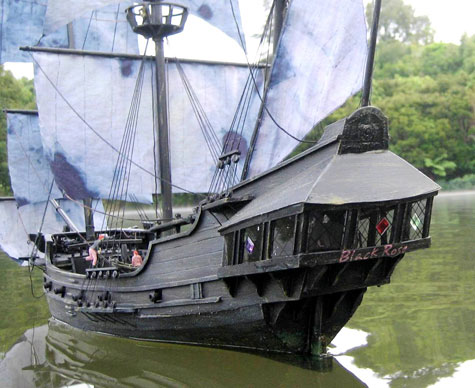
Waiting on the tide
She’s coming at last in the next issue, the Black Rose to be precise. Those who loaned and read, or preferably bought a copy of Marine Modelling International’s November 2010 issue will have read my story and will now have access to my colleague and friend, Harry Duncan’s `how to make the boat’ drawings. Sail it Freesail, line-control or RC, the choice is yours. Look out for the Black Rose scheduled to sail in on this website on or about the 26th March – you never can tell with winds and tides… and other pirates encountered on the way! “ARRRGH! SET ALL SAILS FER NOO ZEA-LAND!”
-30-
| 
